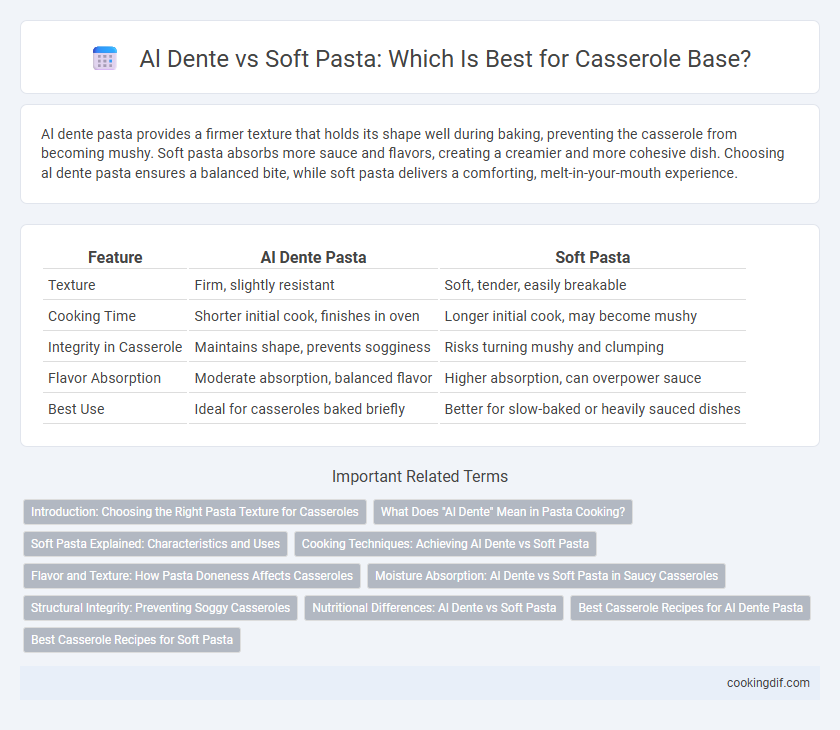Al dente pasta provides a firmer texture that holds its shape well during baking, preventing the casserole from becoming mushy. Soft pasta absorbs more sauce and flavors, creating a creamier and more cohesive dish. Choosing al dente pasta ensures a balanced bite, while soft pasta delivers a comforting, melt-in-your-mouth experience.
Table of Comparison
| Feature | Al Dente Pasta | Soft Pasta |
|---|---|---|
| Texture | Firm, slightly resistant | Soft, tender, easily breakable |
| Cooking Time | Shorter initial cook, finishes in oven | Longer initial cook, may become mushy |
| Integrity in Casserole | Maintains shape, prevents sogginess | Risks turning mushy and clumping |
| Flavor Absorption | Moderate absorption, balanced flavor | Higher absorption, can overpower sauce |
| Best Use | Ideal for casseroles baked briefly | Better for slow-baked or heavily sauced dishes |
Introduction: Choosing the Right Pasta Texture for Casseroles
Selecting al dente pasta for casseroles ensures the noodles maintain firmness and structure during baking, preventing sogginess in the final dish. Soft pasta, while easier to mix with sauces, often results in a mushy texture after prolonged oven time. Balancing pasta texture with baking duration optimizes both mouthfeel and overall casserole integrity.
What Does "Al Dente" Mean in Pasta Cooking?
Al dente" describes pasta cooked to be firm to the bite, providing a slightly resistant texture that holds up well in casseroles without becoming mushy. In contrast, soft pasta absorbs more sauce and can result in a heavier, less structured casserole base. Understanding al dente cooking ensures the pasta maintains its integrity and texture, crucial for a balanced and satisfying casserole dish.
Soft Pasta Explained: Characteristics and Uses
Soft pasta, characterized by its tender and fully cooked texture, absorbs sauce and flavors more effectively, making it ideal for casserole bases that require a cohesive, creamy consistency. Unlike al dente pasta, which retains firmness and a slight bite, soft pasta blends smoothly with ingredients, ensuring an even distribution of moisture and taste. This texture is preferred in casseroles such as baked macaroni and cheese or tuna noodle bake, where a soft, comforting mouthfeel is essential.
Cooking Techniques: Achieving Al Dente vs Soft Pasta
Achieving al dente pasta for a casserole base requires slightly undercooking the pasta by boiling it 1-2 minutes less than package instructions, ensuring it retains a firm texture during baking. In contrast, soft pasta involves cooking the pasta fully before combining, allowing it to absorb more sauce and result in a creamier, tender casserole. Mastering these techniques impacts the dish's texture balance, with al dente providing bite and soft pasta offering a comfortingly smooth consistency.
Flavor and Texture: How Pasta Doneness Affects Casseroles
Al dente pasta retains a firm texture that provides a satisfying bite and prevents the casserole from becoming mushy, enhancing the overall mouthfeel and allowing sauces to cling better, boosting flavor intensity. Soft pasta absorbs more sauce and becomes tender, creating a creamier, smoother casserole but risks losing structural integrity and resulting in a heavier, less distinct texture. Choosing the right pasta doneness impacts flavor balance and texture harmony, making al dente ideal for casseroles requiring clear pasta definition, while soft pasta suits recipes emphasizing softness and sauce incorporation.
Moisture Absorption: Al Dente vs Soft Pasta in Saucy Casseroles
Al dente pasta maintains a firmer texture that limits excessive moisture absorption, helping to retain the casserole's intended sauce balance and prevent sogginess. In contrast, soft pasta absorbs more moisture, resulting in a creamier but potentially mushy base that can dilute flavors and alter the dish's consistency. Selecting al dente pasta optimizes moisture control, preserving both texture and taste in saucy casseroles.
Structural Integrity: Preventing Soggy Casseroles
Al dente pasta maintains structural integrity in casseroles by resisting overcooking and absorbing less sauce, preventing a soggy base. Soft pasta tends to break down during baking, releasing excess starch that leads to a mushy texture. Choosing al dente pasta ensures a firmer casserole foundation with distinct pasta shapes and improved texture.
Nutritional Differences: Al Dente vs Soft Pasta
Al dente pasta retains a firmer texture and lower glycemic index compared to soft pasta, resulting in slower digestion and more stable blood sugar levels. Soft pasta, cooked longer, has higher starch gelatinization which increases its glycemic response and reduces resistant starch content, impacting fiber intake negatively. Nutritionally, al dente pasta preserves more nutrients and provides greater satiety, making it a healthier base choice for casseroles.
Best Casserole Recipes for Al Dente Pasta
Al dente pasta provides the ideal texture for casseroles, maintaining firmness and preventing sogginess during baking. Recipes featuring al dente pasta allow the sauce to absorb flavors without compromising structural integrity, resulting in a perfectly balanced dish. Best casserole recipes for al dente pasta include classic baked ziti, creamy chicken Alfredo bake, and vegetable lasagna that highlight this optimal pasta firmness.
Best Casserole Recipes for Soft Pasta
Soft pasta serves as the ideal base for casseroles, absorbing sauces and flavors thoroughly while maintaining a creamy texture. Best casserole recipes using soft pasta include baked ziti with ricotta and mozzarella or creamy chicken and mushroom casserole, where the tender pasta melds perfectly with rich, savory ingredients. Choosing soft pasta over al dente ensures a cohesive dish with a comforting, melt-in-your-mouth consistency essential for classic baked casseroles.
Al dente pasta vs Soft pasta for casserole base Infographic

 cookingdif.com
cookingdif.com